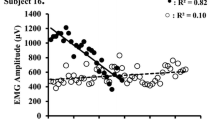Abstract
The shift in the power spectrum resulting from a 5–7 min fatigue-inducing effort followed by a 1–2 min recovery period of two elbow flexors, the biceps brachii (BB) and the brachio-radialis (BR), was assessed using two variables, the mean frequency Fm and the median or central frequency Fmd. These two variables were calculated in pre- and post-fatigue conditions and following a brief recovery, at four levels, namely 20, 40, 60 and 80 per cent of maximum voluntary contraction (MVC). These were taken from a ramped isometric effort that is from 0 to 100 per cent MVC. The EMG activity of the two flexors was recorded with bipolar surface electrodes from a group of ten volunteers. Following muscle fatigue, induced with a maintained 60 per cent MVC isometric contraction, a statistically significant (p<0·05) shift towards the lower frequencies was observed for both Fm and Fmd for both muscles. Following a brief recovery, a shift towards the pre-fatigue higher frequencies was statistically significant (p<0·05). These two synergists responded to muscle fatigue and recovery similarly, as they both demonstrated parallel shifts in power spectrum. The power spectrum is consequently a reliable measure of muscular fatigue. It is also complementary to the net articular moment results.
Similar content being viewed by others
References
Currier, D. P. (1969) Measurement of muscle fatigue.Phys. Ther.,49, 724–730.
DeLuca, C. J. (1983) Myoelectrical manifestations of localized muscular fatigue in humans.CRC Crit. Rev. Biomed. Eng.,11, 251–279.
De Vries, H. A. (1968) Method for evaluation of muscle fatigue and endurance from electromyographic fatigue curves.Am. J. Phys. Med.,47, 125–135.
Eberstein, A. andBeattie, B. (1985) Simultaneous measurement of muscle conduction velocity and EMG power spectrum changes during fatigue.Muscle & Nerve,8, 768–773.
Henneman, E. (1981) Recruitment of motoneurons: the size principle. InProgress in Clinical Neurophysiology.Desmedt, J. E. (Ed.), Karger, Basel, Chap. 9, 26–60.
Johnson, M. A., Polgar, J., Weightman, D. andAppleton, D. (1973) Data on the distribution of fibre types in thirty-six human muscles: an autopsy study.J. Neurol. Sci.,18, 111–129.
Komi, P. V. andTesch, P. (1979) EMG frequency spectrum, muscle structure, and fatigue during dynamic contractions in man.Eur. J. Appl. Physiol.,42, 41–50.
Lenman, J. A. R. (1959) Quantitative electromyographic changes associated with muscular weakness.J. Neurol. Neurosurg. Psychiat.,22, 306–310.
Lloyd, A. J. (1971) Surface electromyography during sustained isometric contractions.J. Appl. Physiol.,30, 713–719.
Merletti, R., Biey, D., Biey, M., Prato, G. andOrusa, A. (1985) On-line monitoring of the median frequency of the surface EMG power spectrum.IEEE Trans.,BME-32, 1–7.
Milner-Brown, H. S. andMiller, G. (1986) Muscle membrane excitation and impulse propagation velocity are reduced during muscle fatigue.Muscle & Nerve,9, 367–374.
Milner-Brown, H. S., Mellenthin, M. andMiller, R. G. (1986) Quantifying human muscle strength, endurance and fatigue.Arch. Phys. Med. Rehabil.,67, 530–535.
Moritani, T., Nagata, A. andMuro, M. (1982) Electromyographic manifestations of muscular fatigue.Med. Sci. Sports Exerc.,14, 198–202.
Moritani, T. andMuro, M. (1987) Motor unit activity and surface electromyogram power spectrum during increasing force of contraction.Eur. J. Appl. Physiol.,56, 260–265.
Mulder, T. andHulstijn, W. (1984) The effects of fatigue and task repetition on the surface electromyographic signal.Psychophysiol.,21, 528–534.
Muro, M., Nagata, A., Murakami, K. andMoritani, T. (1982) Surface EMG power spectral analysis of neuromuscular disorders during isometric and isotonic contractions.Am. J. Phys. Med.,61, 244–254.
Myers, J. L. (1972)Fundamentals of experimental design, 2nd edn. Allyn & Bacon Inc., London.
Naeije, M. andZorn, H. (1982) Relation between EMG power spectrum shifts and muscle fibre action potential conduction velocity changes during local muscular fatigue in man.Eur. J. Appl. Physiol.,50, 23–33.
Ochs, R. M., Smith, J. andEdgerton, V. R. (1977) Fatigue characteristics of human gastrocnemius and soleus muscles.Electromyogr. Clin. Neurophysiol.,17, 297–306.
Petrofsky, J. S., Glaser, R. M., Phillips, C. A., Lind, A. R. andWilliams, C. (1982) Evaluation of the amplitude and frequency components of the surface EMG as an index of muscle fatigue.Ergonomics,25, 213–223.
Smyth, G., Arsenault, A. B., Nagata, S., Gagnon, D. andMathieu, P. A. (1990) Slope of the EMG/moment relationship as a measure of muscular fatigue: a validation study.Med. & Biol. Eng. & Comput.,28.
Stulen, F. B. andDeLuca, C. J. (1981) Frequency parameters of the myoelectric signal as a measure of muscle conduction velocity.IEEE Trans.,BME-28, 515–523.
Sypert, G. W. andMunson, J. B. (1981) Basis of segmental motor control: motoneuron size or motor unit type?Neurosurg.,8, 608–621.
Yang, J. F. andWinter, D. A. (1983) Electromyography reliability in maximal and submaximal isometric contractions.Arch. Phys. Med. Rehab.,64, 417–420.
Author information
Authors and Affiliations
Rights and permissions
About this article
Cite this article
Nagata, S., Arsenault, A.B., Gagnon, D. et al. EMG power spectrum as a measure of muscular fatigue at different levels of contraction. Med. Biol. Eng. Comput. 28, 374–378 (1990). https://doi.org/10.1007/BF02446157
Received:
Accepted:
Issue Date:
DOI: https://doi.org/10.1007/BF02446157




